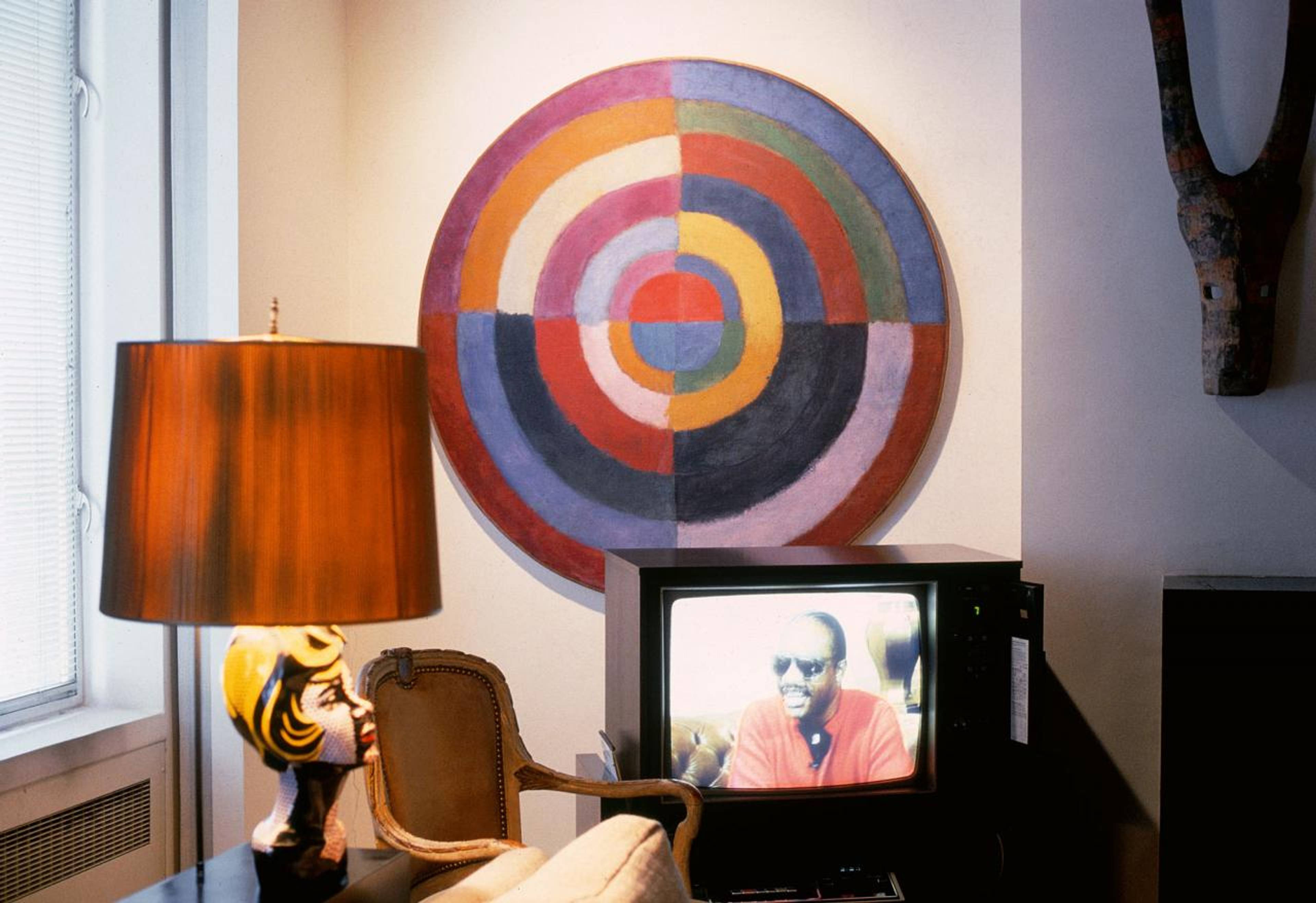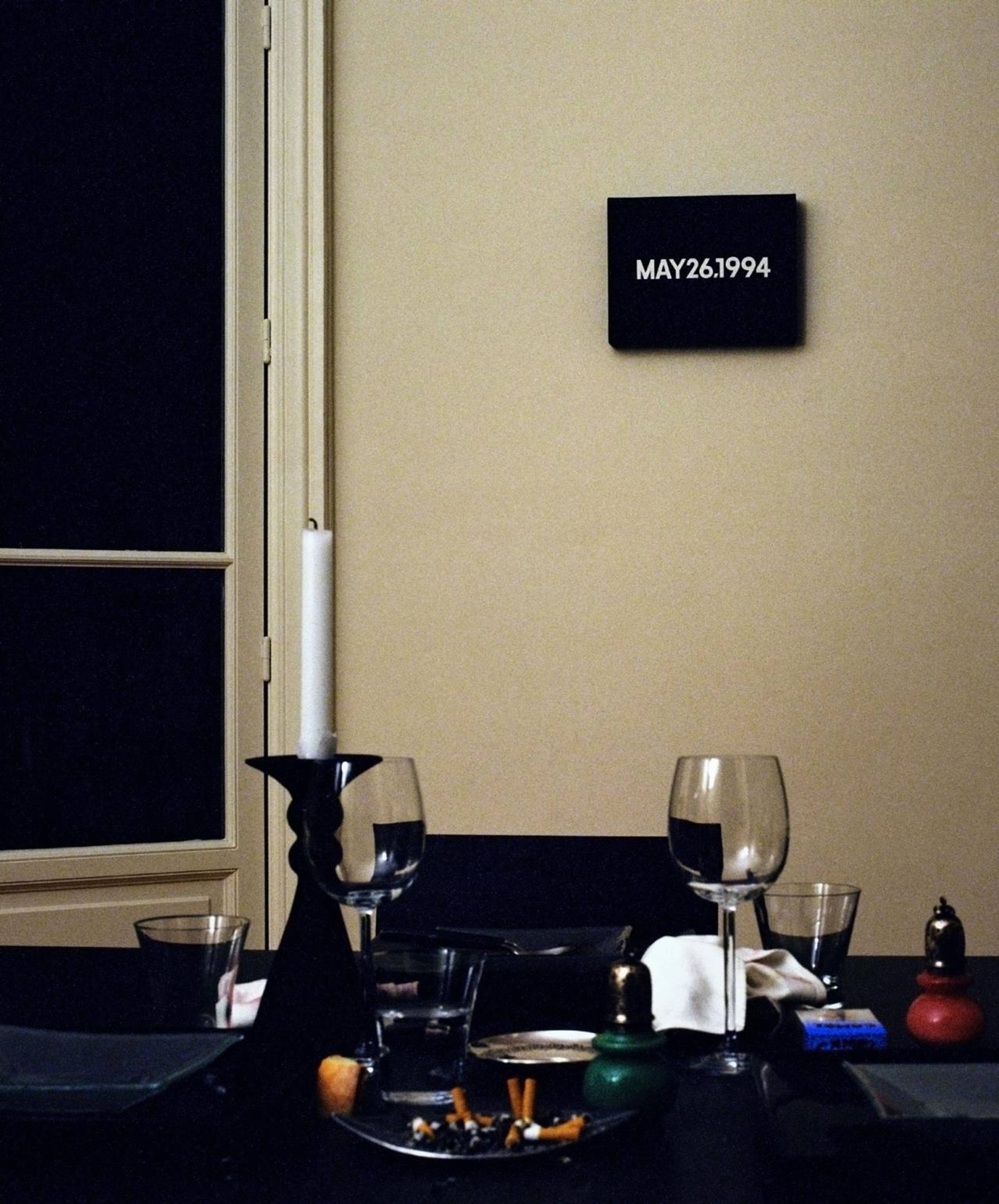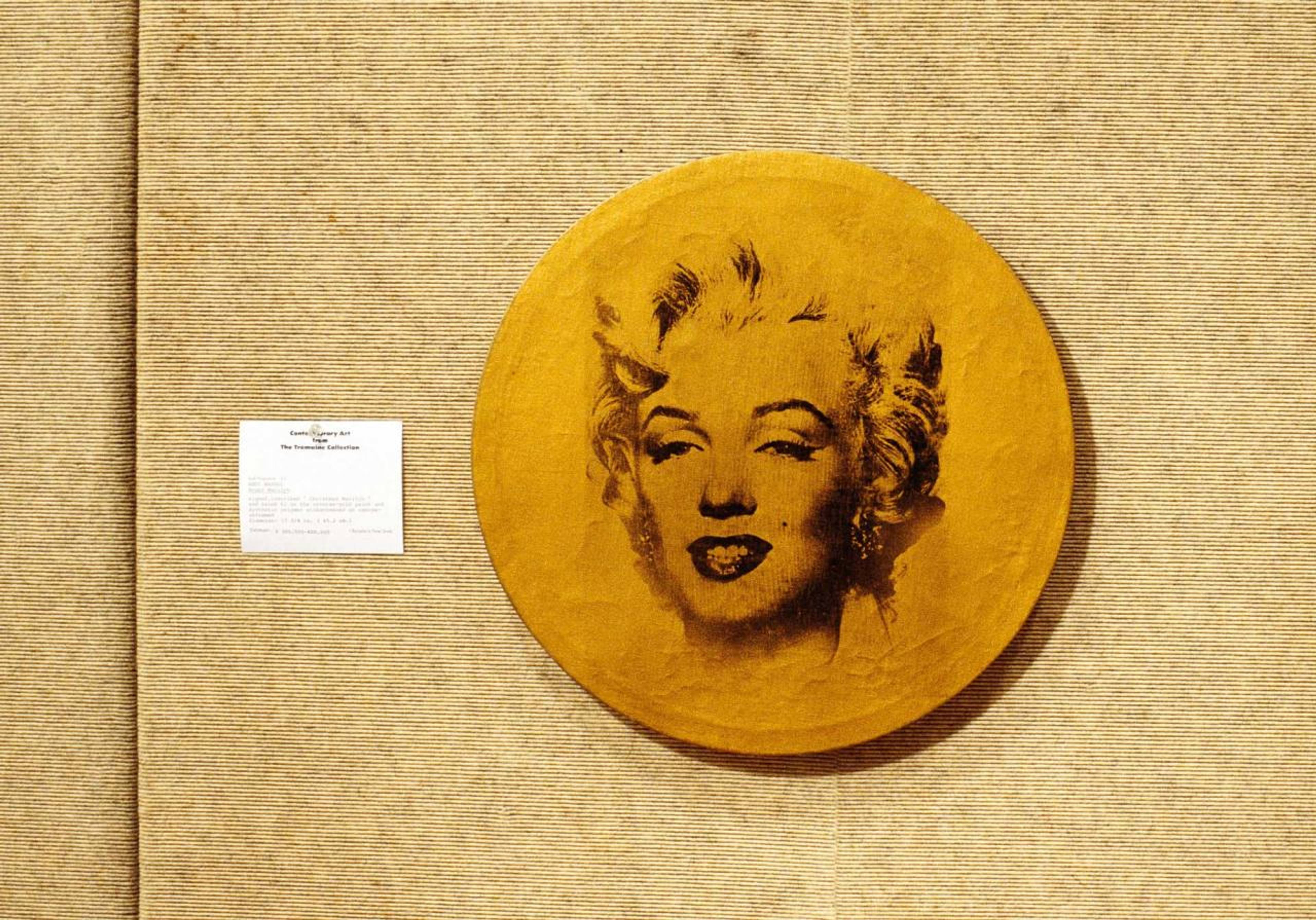I’ve seen Louise Lawler’s work in both the worst and the best way possible: in the warehouse of the gallery that represents her in Berlin. The white walls of the viewing corner, far from Sprüth Magers’s city-center spot, were not high enough. Cardboard boxes and plastic-packed canvases looked down from overhead; others were being wrapped by preparators who were giggling, moving clattering carts behind those thin partitions. It was impossible to focus on the five works on the walls as though in an unfettered space, without acknowledging that I was in a storage unit. And this is precisely what Louise Lawler wants to make you feel in encountering one of her pieces: the circumstances that define the way art is accessed, how it gets to be distributed, observed, decoded.
How different does a Warhol look stacked on a storehouse floor, above silk sheets in a collector’s bedroom, reproduced on a matchbox, hung behind an auction-house altar step, well-lit on a museum wall? Does Andy Warhol Make You Cry? Lawler asks in the title of a photograph she took of the Pop Art icon’s painting Gold Marylin Monroe (1962), mounted on an ecru panel at a Christie’s auction in 1988 – a work the artist as (unfeeling) machine made shortly after the diva’s death from drug overdose. Does Marylin Monroe Make You Cry? asks the title of a second, identical photograph that Lawler shows as a distinct work. Does the price on the painting’s auction-item label make you cry? Would you have cried any differently if you had seen that same Marylin in an institutional retrospective? In a movie? On a phone?
Louise Lawler, Nude, 2002/2003, silver dye bleach print on museum box, 151 x 120.5 cm
Since the end of the 1970s, Lawler has done one singular work, only exploded in endless inflections: She follows the embodiments, connotations, spells that take place when art leaves the studio. Hers are photographs of artworks in homes, galleries, museums, fairs, auction houses, warehouses. Hers are artworks transposed into less highly ranked guises like drinking glasses, matchboxes, stationery, cocktail napkins, wallpapers, and paperweights. She wants us to look at what happens if we read a technical title ( Arranged by Mr. and Mr. Burton Tremaine, Connecticut , 1984) versus a more poetic one ( Once There Was a Little Boy and Everything Turned Out Alright. THE END , 1993). For her very first show, in 1978 at New York’s Artists Space, she borrowed an 1883 oil painting of a horse from a local race track and hung a pair of thousand-watt lights overtop, one directed at the viewers, the other through the gallery space and out of a window, projecting the beam across the street. Since 2017, she has repurposed her own, earlier photographs, warping them to the extent that the real-life sceneries, objects, Warhols become abstractions. She calls the series “Distorted for the Times.” Is the aura still there, then? What bends an object to the point it becomes sublime, ritual, or sentimental? What makes it critical? When is it a commodity, purely? When is it supplementary, chaperoning other things, and when a protagonist?
In one of her more renowned pictures, Pollock and Tureen (1984), Lawler shot the heavily cropped bottom edge of a Jackson Pollock above a ceramic dish for serving soup, its vermilion top handle resembling creamy drips of Expressionist paint. Both artifacts decorate a dining room, but maybe one has a more poignant function, is more center stage. If Gerhard Richter’s untouchable Ema (Nude on a Staircase) (1966) is left propped on its side in a stark white corridor, wooden moldings scattered on the ground, abandoned in an art-fair aisle ( Nude , 2002–03), does it fall off center stage?
Her photographs may be critical, at times denouncing the more uncomfortable side of a thing, but they do not oppose it. Rather, they linger on it, and ask how you feel if you linger with them.
Much post-WW II art explicitly addressed the terms of its reception – Minimal art, Conceptual art, Institutional Critique – and the Pictures Generation, with whom Lawler emerged in the 1980s, was intent on exposing the regime of images that commanded modern life. Yet Lawler doesn’t fit precisely in any of these currents. “It is no longer a matter of trying to subvert or intrude,” she told Martha Buskirk in 1994, in one of her rare interviews. “Those strategies are now recognized and invited. Now it is a matter of finessing, which is certainly not enough.” Her photographs may be critical, at times denouncing the more uncomfortable side of a thing, but they do not oppose it. Rather, they linger on it, and ask how you feel if you linger with them, on those spots of the mind where, if interpellated, you are not exactly sure which position to take.
Is She Ours? (1990) queries Lawler of Degas’s Little Dancer (c. 1878–81), captured in a glass vitrine at Boston’s Museum of Fine Arts. Or is she someone’s only if she’s privately owned? Andy’s or Marylin’s? Which side of the story do you feel addressed by? In a 2003 diptych, she portrayed the moment after a dinner has ended, cigarettes squeezed together in an ashtray, napkins crushed up, glasses empty, an On Kawara date painting hung on the wall: MAY 26, 1994 . One of the photos is called Still Life (Napkins) ; the other, arresting the table slightly to the left, Still Life (Candle) . Something catches your attention more than another, one white element in a rather darkly lit circumstance pulling you more than the other, a candle or a napkin, when life gets still. Maybe you catch the white-painted letters on the wall then, or maybe they remain ancillary, in the background.
Louise Lawler, Still Life (Candle), 2003, silver dye bleach print on museum box, 33 x 27.5 cm
“Art is no longer being produced, but only watched,” Martin Kippenberger said in 1990, understanding how “simply to hang a painting on a wall and say it’s art is dreadful.” Who is watching is part of art. “American women are experts in that. From Holzer on, to Kruger, Lawler, Fraser.” Thirty-three years on, how do we watch, how do we figure as part of what we watch? Artist Dena Yago said that viewers primarily provide unpaid labor by producing “user-generated content,” or UGC. Back then, in 2018, Yayoi Kusama’s Infinity Mirrored Room – The Souls of Millions of Light Years Away (2013) installed at The Broad in Los Angeles had been hashtagged in over 44,000 Instagram posts. It’s almost 95,400 today, nearly all selfies. We look at art to be looked at, optimized and distracted by our screens. Looking at one image to make another, simultaneously consumers and producers – prosumers – has made exhibitions into content farms. “The transformation of artworks and installations into attractions has increased ticket sales for art institutions,” Yago continues, “while democratizing access to a certain type of spectacular, installation-based art.” To compete with and beat cute animal memes, museums need to exhibit, and probably to collect, in a new way. Try the hashtag #boursedecommerce.
Lawler’s latest body of work focuses on Donald Judd’s sculptures as they appeared in the 2020–21 “Judd” at New York’s MoMA, one of the largest-ever retrospectives of the late American Minimalist. “LIGHTS OFF, AFTER HOURS, IN THE DARK” (2021) is a series of photographs taken over the course of two nights, after the museum had closed. On glossy, almost pitch-black surfaces, Judd’s shiny stacks, his aluminum parallelepipeds, his yellows and blues turn into gray, sharp-edged voids, the red of the emergency exit sign the only color to be seen. Largescale photos do act as mirrors more often than not; here, though, onlookers materialize as gloomy visitations in the museum’s deserted rooms – prosumerists have to strain their eyes to catch the works on camera.
Who, these days, can afford the patience for mixed feelings about the protocols of cultural institutions?
Twenty years prior, in 1999, Lawler produced white cocktail napkins featuring a small, square-bulleted list, as if one had to tick one of the following:
☐ The Museum as Muse
☐ The Museum in Use
☐ Natural History and Ethnography
☐ The Museum Transformed
☐ Museum Politics
☐ Cereal for Breakfast
☐ Soup for Lunch
☐ Art for Museums
☐ ◼ ▲ ● ◼ ▲ ●
The napkins were distributed during the opening of a group show and were intended to be available at MoMA’s cafeteria and restaurant for the duration of the exhibition. Three years prior, Nicolas Bourriaud had coined the term “relational aesthetics,” indeed transforming the museum with soup for lunch – definitely needing Lawler’s paper cloths. What other boxes could she add today, with museums on the brink of becoming post-aesthetic, social sculptures (again), at a moment when art is assessed on the basis of its social utility, its edifying effect of repair, more so than its aesthetic (ambi)valence? “Who, these days, can afford the patience for mixed feelings about the protocols of cultural institutions?” Peter Schjeldahl asked in reviewing one of her shows in 2017.
And yet, it’s still a matter of Louise Lawler’s finessing, even if we linger on a candle only when it’s photogenic, if souvenirs are no longer matchboxes, but selfies, even if private and public are not rival poles these days – not in labor, politics, identity, or media – even if the wealthy are farcically mocked by all of us ( The White Lotus won five Emmys). Maybe finessing is more enough today than thirty years ago, when signification was not stuck within screens, and there was less pressure to signal virtue. Art, as any other credo, is still never watched “as such.”
Louise Lawler, Does Marilyn Monroe Make You Cry?, 1988, silver dye bleach print with text on Plexiglas wall label, image: 69 x 99 cm; label: 11 x 16 cm
Louise Lawler, Does Andy Warhol Make You Cry?, 1988, silver dye bleach print with text on Plexiglas wall label, image: 69 x 99 cm; Plexiglas label: 11 x 16 x 16 cm
LOUISE LAWLER (*1947, Bronxville, New York) is an artist based in Brooklyn. Of late, she has been the subject of retrospectives at, among others, Sprüth Magers, Berlin; Metro Pictures, New York (both 2021); The Art Institute of Chicago (2019); Sammlung Verbund, Vienna (2018); MoMA, New York (2017). She has recently participated in the group shows “Capturing the Moment,” Tate Modern, London (2023); “The Milk of Dreams,” 59th International Art Exhibition, La Biennale di Venezia; “Ceremony (Burial of an Undead World),” Haus der Kulturen der Welt, Berlin; “NOT I: Throwing Voices (1500 BCE – 2020 CE),” LACMA, Los Angeles; “Changes,” Museum Moderner Kunst Stiftung Ludwig Wien – mumok, Vienna; “Somewhere Downtown: Art in 1980s New York,” UCCA Center for Contemporary Art, Beijing (all 2022).
___
– This text appears in Spike #75 – The Museum Issue . You can buy it in our online shop –





